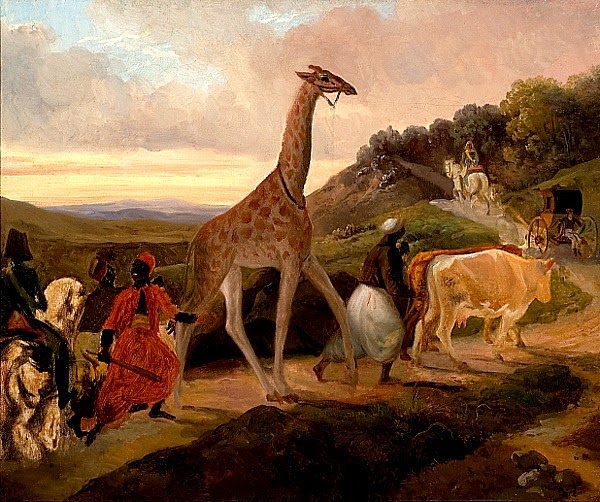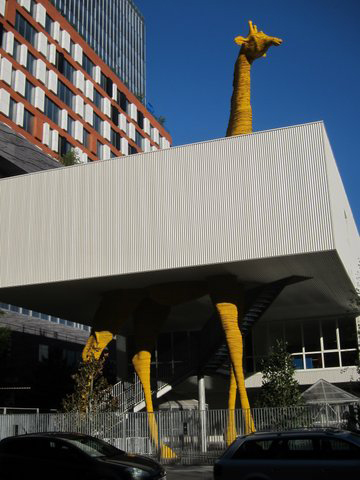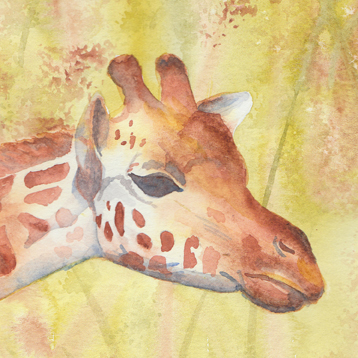Two obelisks from the entrance to Luxor Temple were offered to France by the Viceroy of Egypt in 1830. One thrones on the place de la Condorde still today. But did you know there was another precious gift from the Viceroy just a few years earlier? Rosa Bonheur moved to Paris from Bordeaux, she was 7 years old at the time and did not like Paris at all until she discovered Paris’ latest phenomenon… Zarafa.
In 1826 Muhammad Ali Pasha, the Viceroy of Egypt, gave Zarafa (Arabic for «Giraffe», literally «charming» or «lovely one»), the first living giraffe to set foot on French soil, to Charles X as a diplomatic gift. She was separated from her mother at 3 months of age, traveled 2000 miles down the Nile, then across the Mediterranean by boat, arriving in Marseilles, where she would spend her first winter acclimatizing. The following spring, she left for Paris on a 41 day walk (880km) accompanied by 55 year old French naturalist Étienne Geoffroy Saint-Hilaire.
Each stage of the journey to Paris was prepared down to the last detail. The caravan included the giraffe, two cows, one antelope, two moufflons, a cowhand, the Sudanese keepers, an interpreter and a cart loaded with forage, seeds and a variety of other items. To protect her from rain, a two-piece coat with a hood was tailor-made and decorated with the arms of the King of France and the Pasha of Egypt. Some accounts say she also wore booties.
Each town the group passed through greeted them with delighted onlookers. This was the first giraffe they had ever seen. Upon her arrival in Paris, Zarafa was presented to Charles X at the chateau of Saint-Cloud in Paris on 9 July 1827. To honor her the King offered some rose petals from his royal hand. Then she took up residence in the Royal Menagerie, the modern day Jardin des Plantes. The excitement of the newcomer’s arrival resulted in a genuine «giraffomania» producing of a wide variety of giraffe-related objects from painted porcelain and spotted fabrics. Smoothing irons, warming-pans, ink-wells, fans, soaps, snuff-boxes, wallpaper and poems, almanachs and publications of every sort came out with giraffe motifs. And there were some very tall hairstyles! The lastest lingo had the romantics swooning before their belle’s «Giraffe eyes». Over 600,000 people came to see her the first year. Honoré de Balzac wrote a story about her; Jacques Raymond Brascassat painted her portrait.
Plans to mate her to a giraffe from Italy never came to fruition. She died in 1845, outliving both Charles X and Geoffroy Saint-Hilaire. She was preserved and mounted on a wooden frame. In 1931, she was donated to La Rochelle’s Natural History Museum and can still be seen there today as the emblem of the museum.
The Egyptian viceroy’s gifts were politically motivated: He commanded the Turkish forces which were fighting the Greeks in their war of independence. Ali hoped his gifts would improve relations and thus the French King would not intervene in support of the Greeks. Although France was smitten with its «beautiful stranger» they did not stay out of Ali’s way.
In 2012 Giraffomania returned to Paris with the animated film Zarafa by Rémi Besançon and Jean-Christophe Lie. Their version of the story was re-written for a younger audience and revolved around the little boy, Maki, as much as the giraffe. It takes on the themes of slavery, colonialism and good versus evil while entertaining one and all with adventure. One fantasy element is added by having the group travel across the Mediterranean by hot air balloon. The same year Nathan Publishing brought out a set of 4 French children’s books, the Musée du Jardin des Plantes presented an exhibition about Zarafa’s trip to Paris and a new giraffe preschool opened in Boulogne-Billancourt.
2014 brought yet another Giraffe movie, the reopening of the Zoo de Vincennes with 16 giraffes and the Sophie La Giraffe photos contest. The movie Girafada recounts the story of Yacine and his son Ziad. Yacine is the veterinarian in the last zoo in Palestine. Ziad particularly loves the giraffes. One night after an air raid the male giraffe dies. The female cannot live on her own and slowly wanes. Yacine must urgently find a new companion giraffe, but the nearest zoo with a male giraffe is in Tel-Aviv…
Then there is the classic French giraffe. Do you know Sophie La Girafe? This natural rubber toy is the iconic baby item in France. It was created in 1961 and has continued to be the most popular baby toy since. It squeaks gently and is good to chew on. If you need to send a baby gift back home think of Sophie – available everywhere, easy to mail, inexpensive, made in France and so so French. Read Sophie’s story or enter the photo contest.
Do you know the expression: Peigner la girafe? It means…
To beat a dead horse – To preach to the choir – To carry coal to Newcastle (ask an English friend to decipher this for you) – To screw a tornado (from the midwest?) … you’ve surely understood by now that to « comb the giraffe » means to do a long, useless task…
And take note while in English the word giraffe takes two « f »s there’s only one in French! I can never remember which is which. Thank heavens they both only take one « r »!
Other Parisian animals:





